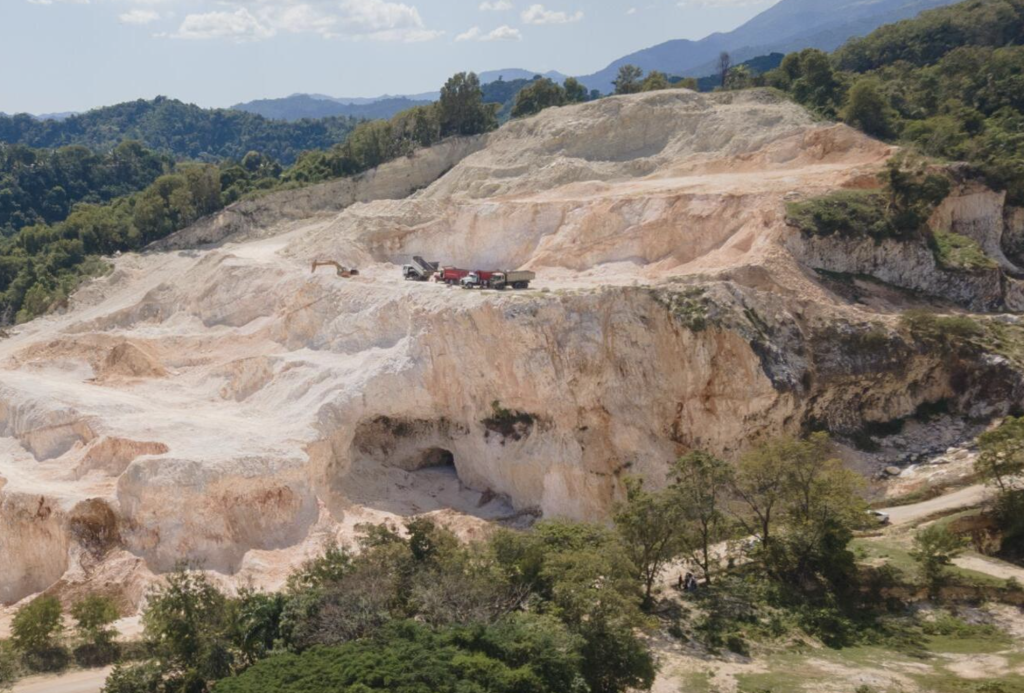
After decades of allowing aggregate mining companies to destroy the area known as the Pomier Caves in San Cristobal, now Minister of Environment Paino Henriquez with the support of President Luis Abinader is backing those who see more value in the touristic and cultural heritage of the caves than in aggregate.
President Luis Abinader took advantage of his annual state of the nation address on 27 February 2025 to announce the government has militarized the area to impede the continuing of the aggregate mining. He said the government is coming to the rescue of the caves and will submit a request for these to be recognized as cultural heritage to the Unesco. He responds to decades of efforts of cave specialist Domingo Abreu, together with others such as Luis Carvajal of the state university UASD, cultural promoter Omar Bros and Ricardo Ripoll of Somos Pueblo who for years have advocated the government put a stop to the destruction of the site.
President Luis Abinader in his address unveiled a bold plan to rescue and protect the Cuevas de Borbón or Pomier Anthropological Reserve.
During his national address, Abinader announced an immediate ban on all mining operations within the reserve and its buffer zone. He also launched an initiative to transform the caves into the “Prehistoric Capital of the Caribbean.”
“Today, we face the urgent need to rescue this heritage that belongs to all Dominicans. We will not wait any longer,” said the President.
To achieve this, he explained the Ministry of Environment had issued a resolution ordering the immediate cessation of mining activities in the core area and its buffer zones. Additionally, collaboration has been requested from the universities UASD, Intec, and PUCMM to quickly design a remediation plan. “I have also instructed the Ministry of Defense to have the army intervene in the area, ensuring the safety and protection of this valuable heritage, which they did yesterday.” he reported when speaking on 27 February 2025.
“Furthermore, I have tasked the Ministry of Environment, the Ministry of Culture, the Ministry of Tourism, Egehid, Propeep, and Supérate with the immediate execution of an action plan aimed at transforming the Pomier Caves into the Prehistoric Capital of the Caribbean. This plan will include support for families who have depended on artisanal mining, ensuring their livelihoods are not affected during the transition.
“Finally, once these efforts are completed, we will request that UNESCO declare the Pomier Caves a World Heritage Site, further reaffirming their immeasurable value to our identity and history,” he stated.
The President pledged to seek UNESCO World Heritage status for the site once ongoing restoration efforts are completed. Describing the caves as a “fundamental archaeological reference” since the 19th Century, Abinader noted that decades of non-metallic mining in the area have led to constant conflict between authorities, communities, and mining companies.
“Twenty-three years after its protection was established, legal and illegal mining operations continue to threaten the core and buffer zone of this natural monument,” Abinader stated. “We can wait no longer. This heritage belongs to all Dominicans, and we must rescue it now.”
The plan will be spearheaded by a task force including the ministries of Environment, Culture, and Tourism, the Dominican Hydroelectric Generation Company (Egehid), the Strategic and Special Projects Agency (Propeep), and Supérate, the welfare program. It will prioritize supporting families who rely on artisanal mining, ensuring their livelihoods are not adversely affected during the transition.
The rescue effort will be supported by a resolution issued by the Ministry of Environment prohibiting all mining activity within the reserve’s core area and buffer zone. The resolution, signed by Minister Paíno Henríquez, cites technical inspections revealing non-compliance and violations of environmental laws due to mining activities. It also calls for collaboration with leading Dominican universities – the Autonomous University of Santo Domingo (UASD), the Technological Institute of Santo Domingo (Intec), and the Catholic University Madre Maestra (PUCMM) – to design a comprehensive remediation plan.
The Cuevas de Borbón or Pomier Anthropological Reserve was one of the country’s first protected areas since Cultural Heritage Law 492 of 1969. Then again, the area was designated a protected area in 1993 and later incorporated into the National System of Protected Areas (SINAP) in 2004. The reserve, classified as a Natural Monument (Category III), allows for specific uses such as scientific research, education, recreation, nature tourism, and public infrastructure as outlined in its management plan and authorized by the Ministry of Environment. Nevertheless, governments have not been able to implement effective actions to put a stop to the devastation of the area by powerful private interests.
Read more in Spanish:
Ministry of Environment
Presidency
7 Dias
El Caribe
3 March 2025

